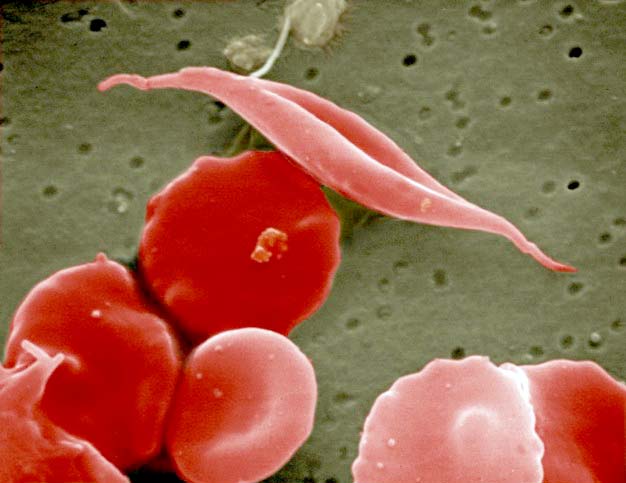Sickle cell anemia is a disease that warps red blood cells into a sickle like shape due to problems with their hemoglobin. Hemoglobin resides inside a red blood cell and carries oxygen from the lungs to all other parts of a body. Healthy hemoglobin stays in a liquid state while residing in the red blood cell and thus allows the red blood cell to be soft and flexible. It is important for a red blood cell to be flexible so that it may squeeze through many small veins in the circulatory system. Hemoglobin affected by sickle cell anemia has the tendency to change from a liquid state and form a crystalline structure that warps the red blood cells shape and hardens it. This makes the affected red blood cell unable to travel all over the body and in some cases can clog veins and arteries because of the texture and shape. Sickle cell anemia also permanently damages the distorted red blood cells and thus triggers the body to kill them off. This can lead to a shortage of healthy red blood cells, which means a lack of oxygen to the many parts of the body.
The majority of sickle cell cases occur among African Americans who are either from Africa or can trace their lineage back to Africa. Other populations that the sickle cell gene is common in are located in the Mediterranean, Middle East, and India areas. These geographic locations are also home to the disease of malaria. It is believed that sickle cell anemia originated in these locations in response to malaria. People infected with sickle cell anemia are less vulnerable to malaria. This has caused an environment where people with the sickle cell disease survived due to less mortality from malaria. As the slave trade began, blacks that were transported to areas devoid of malaria no longer had a use for the sickle cell disease and so it became nothing but a debilitating hindrance.
Sickle cell anemia is passed on to new generations through genetic lineage. Even if both parents do not have sickle cell anemia, it is possible one of them may carry a dormant gene for sickle cell anemia. This disease can then be transferred to a child whose genetic makeup may or may not keep the damaged hemoglobin gene dormant. In the United States there are numerous tests one can take to see if they are a carrier for the disease. Laboratories can then determine the chances of their future children having the disease.

